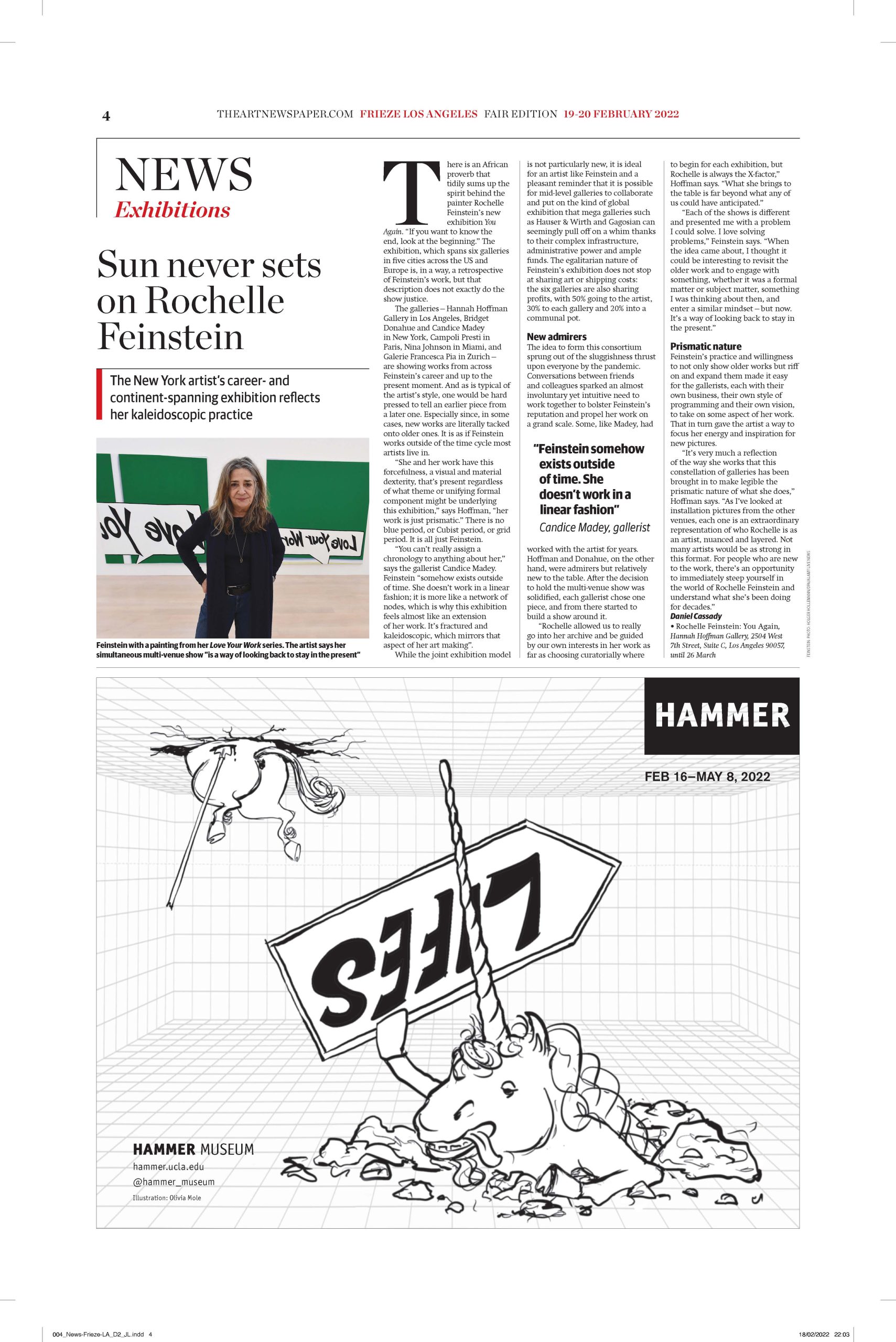Sun never sets on Rochelle Feinstein

By Daniel Cassady
There is an African proverb that tidily sums up the spirit behind the painter Rochelle Feinstein’s new exhibition You Again. “If you want to know the end, look at the beginning.” The exhibition, which spans six galleries in five cities across the US and Europe is, in a way, a retrospective of Feinstein’s work, but that description does not exactly do the show justice.
The galleries—Hannah Hoffman Gallery in Los Angeles, Bridget Donahue and Candice Madey in New York, Campoli Presti in Paris, Nina Johnson in Miami, and Galerie Francesca Pia in Zurich— are showing works from across Feinstein’s career and up to the present moment. And as is typical of the artist’s style, one would be hard pressed to tell an earlier piece from a later one. Especially since, in some cases, new works are literally tacked onto older ones. It is as if Feinstein works outside of the time cycle most artists live in.
“She and her work have this forcefulness, a visual and material dexterity, that’s present regardless of what theme or unifying formal component might be underlying this exhibition,” says Hoffman, “her work is just prismatic.” There is no blue period, or Cubist period, or grid period. It is all just Feinstein. “You can’t really assign a chronology to anything about her,”
says the gallerist Candice Madey. Feinstein “somehow exists outside of time. She doesn’t work in a linear fashion; it is more like a network of nodes, which is why this exhibition feels almost like an extension of her work. It’s fractured and kaleidoscopic, which mirrors that aspect of her art making”.
While the joint exhibition model is not particularly new, it is ideal for an artist like Feinstein and a pleasant reminder that it is possible for mid-level galleries to collaborate and put on the kind of global exhibition that mega galleries such as Hauser & Wirth and Gagosian can seemingly pull off on a whim thanks to their complex infrastructure, administrative power and ample funds. The egalitarian nature of Feinstein’s exhibition does not stop at sharing art or shipping costs: the six galleries are also sharing profits, with 50% going to the artist, 30% to each gallery and 20% into a communal pot.
New admirers
The idea to form this consortium sprung out of the sluggishness thrust upon everyone by the pandemic. Conversations between friends and colleagues sparked an almost involuntary yet intuitive need to work together to bolster Feinstein’s reputation and propel her work on a grand scale. Some, like Madey, had worked with the artist for years. Hoffman and Donahue, on the other hand, were admirers but relatively new to the table. After the decision to hold the multi-venue show was solidified, each gallerist chose one piece, and from there started to build a show around it. “Rochelle allowed us to really go into her archive and be guided by our own interests in her work as far as choosing curatorially where to begin for each exhibition, but
Rochelle is always the X-factor,” Hoffman says. “What she brings to the table is far beyond what any of us could have anticipated.”
“Each of the shows is different and presented me with a problem I could solve. I love solving
problems,” Feinstein says. “When the idea came about, I thought it could be interesting to revisit the older work and to engage with something, whether it was a formal matter or subject matter, something I was thinking about then, and enter a similar mindset—but now. It’s a way of looking back to stay in the present.”
Prismatic nature
Feinstein’s practice and willingness to not only show older works but riff on and expand them made it easy for the gallerists, each with their own business, their own style of programming and their own vision, to take on some aspect of her work. That in turn gave the artist a way to
focus her energy and inspiration for new pictures. “It’s very much a reflection of the way she works that this constellation of galleries has been brought in to make legible the prismatic nature of what she does,” Hoffman says. “As I’ve looked at installation pictures from the other
venues, each one is an extraordinary representation of who Rochelle is as an artist, nuanced and layered. Not many artists would be as strong in this format. For people who are new
to the work, there’s an opportunity to immediately steep yourself in the world of Rochelle Feinstein and understand what she’s been doing for decades.”